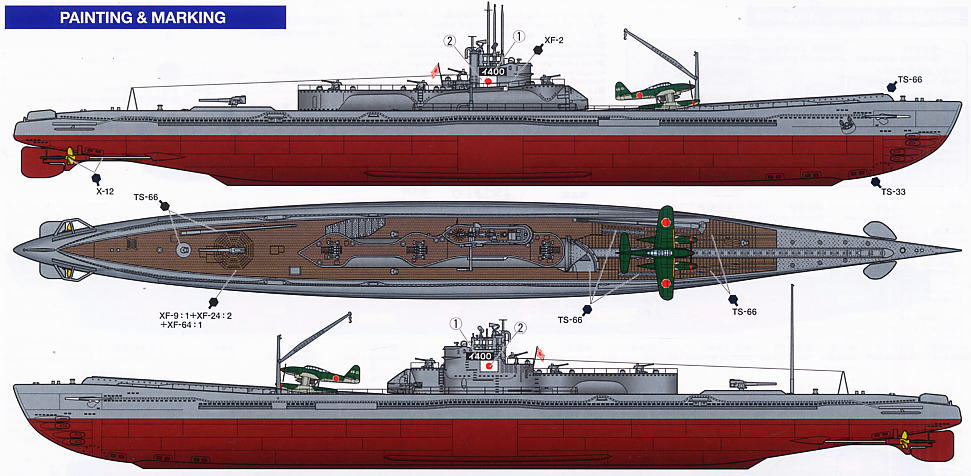THIS IS A JAPANESE artist’s depiction of one of his country’s super submarines constructed near the end of World War II in the Pacific. Admiral Yamamoto ordered 15 of the giant Class I-400 vessels, but only three were put into operation. Plans were to have the subs attack the Panama Canal, but those orders were changed when the U.S. threatened the main islands.
Here’s a little more “infamy” from the history of World War II in the Pacific, which almost brought the war to mid-America.
In the final days of the war, according to historians, the Japanese were considering a plan to attack the Panama Canal, the primary route for America’s transport of troops and supplies from the east coast of the U.S. to the Pacific Theater.
A similar plan had been drawn up at the start of the war, when the Japanese attacked Pearl Harbor, but the campaign was called off. The revived plan was put together later as Japan was building a group of super submarines, underwater aircraft carriers which housed three suicide bombers each.
At the end of May 1945, according to historical documents, final preparations for a secret mission were taking place at the aerial operations division of Imperial Japanese Headquarters.
The secret operation was intended to shatter confidence among those in the U.S., much like the raid on Pearl Harbor. It was a bombing raid on the Panama Canal, which would curtail the waterway’s access to the Pacific.
If it had been successful, the U.S. would have been forced to send troops and supplies overland to the West Coast, or south around South America.
The plan was born right after the Doolittle Raid on the main island of Japan, the first U.S. raid on Tokyo in April 1942. After that, Japanese strategists were determined to launch a counterstrike against America.
At the instigation of Admiral Yamamoto, a series of 15 giant Class I-400 submarines were ordered, each able to carry three special-duty aircraft. These 5,223-ton submarines, with a range of 37,500 nautical miles, were twice as large as the largest vessels in the U.S. Navy, and could remain at sea for four months without refueling.
A catapult stretched from the spacious cylinder-shaped hangar in the starboard hold, forward to the bow.
The aircraft built to take off from the submarines were twin-seater Aichi M6A1 Seiran seaplanes, specially designed for the Panama Canal operation. The Seirans were all equipped with German Daimler-Benz 400 horsepower engines and were designed as the world’s first “throwaway airplanes.” They would drop off the crew after the raid, be ditched from the submarine, and sink at once.
To help ensure that the raid on the Panama Canal came as a surprise, the Japanese planned to attack not from the east, but from the Caribbean Sea to the west. Four submarine aircraft carriers would launch their 12 aircraft shortly before daybreak.
A 25-year-old pilot, Lt. Atsushi Asamura, was assigned to lead the operation, which was planned for mid-July 1945. The plan was to drop bombs and torpedoes on the canal gates and the nerve-centers of the Panama Canal.
As soon as the crews had been taken back on board and the aircraft sunk, the submarine motherships would submerge as rapidly as possible.
The Seiran unit was formed on Dec. 15, 1944, and was officially known as the 613th Air Corps. It’s commander was a Capt. Arizumi, an officer of the 1st Japanese Submarine Flotilla to which the giant submarines belonged.
The new unit was under the overall command of the 6th Fleet in Kure. Two of the best-known members of the newly formed Seiran Corps were officers Nobuo Fujita and Shoji Okuda. Both had been involved in the first and only previous air raid on the U.S. That attack was from Submarine I-25 on Sept. 9, 1942. A Yokosuka E14Y1 was used on that raid, a direct ancestor of the Seirans, according to historical documents.
That 1942 raid in Oregon was an attempt to start a wildfire on the West Coast. Bombs were dropped into the forest, but caused limited damage.
The I-25 submarine was later destroyed by the American Destroyer USS Patterson off New Hebrides on Sept. 3, 1943,
exactly one year from the raid on the Oregon forest. Fujiti and Okuda had previously left the submarine.
The Oregon raid marked the only time during World War II that an enemy plane dropped bombs on the United States mainland.
The Seiran and submarine crews began preparation exercises on April 2, 1945. It was determined that 1,760 pounds was the heaviest bomb load the Seirans could risk carrying on their catapult takeoff. The hangers had been camouflaged with dummy chimneys to disguise the huge submarines from U.S. reconnaissance planes.
On June 25, 1945, Imperial Japanese Headquarters halted preparations for the Japanese attack on the Panama Canal, and issued new orders.
In view of the American threat to the Japanese islands, the 12 Seiran aircraft were ordered to find a suitable opportunity to launch a kamikaze raids (Operation Hikari) against U.S. aircraft carriers; but the Japanese surrender came before the operation was carried out.
With these rapid changes at the end of the war, and a change of plans at the start of the war in the Pacific, the Panama Canal was spared.
